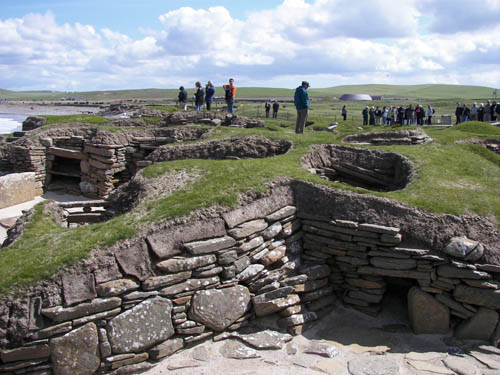SKARA BRAE is not a neolithic village of houses but an “ancient sauna” an expert has claimed.
The former head of Glasgow’s museums and galleries is literally rewriting history with his new book discussing one of the world’s most famous archaeological site.
He insists the rooms built from stone slabs are where ancient people would honour the spirits of their ancestors in the steamy heat of a sauna.
Until now it has been believed the the stone structures uncovered in 1850 where the remains of homes lived in by residents of the Bay of Skaill on Mainland Orkney some 5,000 years ago.

Julian Spalding compares the sites to other stone remains in Turkey and the island of Gozo and says they would have been used as a “temple of storytelling”.
In his book ‘Realisation: From Seeing to Understanding’ he writes: “Skara Brae makes much more sense as a community sauna – a place for telling stories about spirit ancestors through the long winters – than it does as a village, providing everyday accommodation.
“In those early instances stone appears to have been cut for eternal uses, not for the fleeting present.”
Spalding said that the hearths in the rooms of Skara Brae, and the small tanks set in the floors were equipment for the sauna.
He continued: “I think it was a sauna, because it is stone built, and because it just doesn’t look like a village to me – the people were not midgets.
“People in the so called ‘stone age’ really did not cut into stone, they only cut into it if it was for eternity.
“They would have lived in mud or turf and hide huts and places like Skara Brae would have been for the spirits of the dead to return to.
“I am not an expert on Skara Brae but this comes out of travelling the world and thinking about things.
“I think it was a cluster of sacred sauna for different families – and that is why they are all huddled together.”
Skara Brae was built before before the Pyramids, Stonehenge or the Great Wall of China and is one Orkney’s top visitor attractions visited by 55,000 people every year.
Since the site was fully excavated in the 1970s a replica construction has been built, made-up to look like a prehistoric house.
An informative visitor centre with touch-screen presentations was also built.
Not everyone has been convinced by Mr Spalding’s analysis.
Tom Muir, the Exhibitions Officer for Orkney Islands Council, said: “It is always good to discuss these things because it is through ideas that archaeology moves forward.
“It is not a ridiculous notion, but from the similarities to other sites, that does support the idea that this was a village.
“I also wonder if the rooms are too large to be saunas, and the tanks in the floor too small to generate steam.
“Skara Brae does not exist in isolation, there are other sites such as Barnhouse Settlement although Skara Brae is different in that it is recessed into deposits.”
